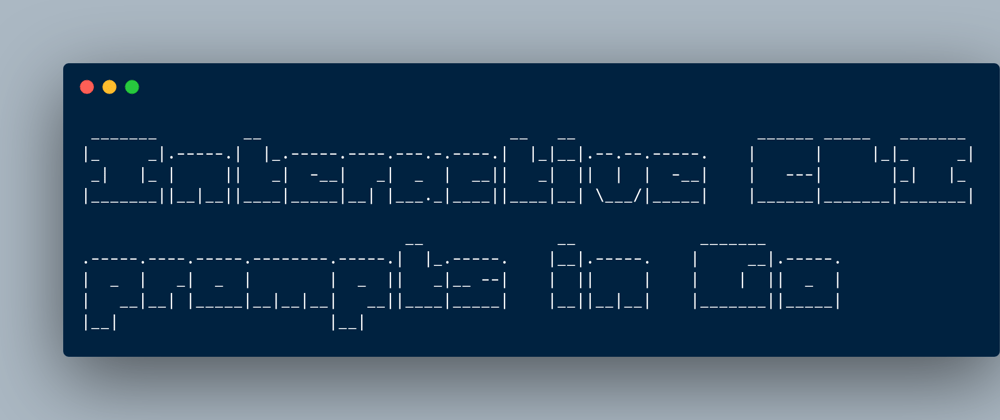Tidal Migrations 💓 CLI applications
Do you like CLI applications? We love them! At Tidal Migrations we use full-featured GUI IDEs and editors like VS Code and Emacs but also vim and git running in our terminals. Every day we use bash, awk, sed and lots of other CLI tools and apps for work and fun. Also, we like to develop CLI apps and with this post, we're going to show you how to implement different interactive prompts for your CLI apps written in Go.
Passing data to CLI apps
Oftentimes CLI applications don't just work by themselves, but some process or operation is required on the information or data.
There are different ways to pass data to command line applications. Using flags, environment variables, file names as CLI arguments or reading from standard input is quite common and is pretty easy to implement using just the standard Go library. Using interactive prompts can spice up your CLI application and improve the overall UX.
Let's get started!
How to implement text input prompt
The basic text input prompt is easy to implement. Just read from standard input until the new line character (\n):
package main
import (
"bufio"
"fmt"
"os"
"strings"
)
// StringPrompt asks for a string value using the label
func StringPrompt(label string) string {
var s string
r := bufio.NewReader(os.Stdin)
for {
fmt.Fprint(os.Stderr, label+" ")
s, _ = r.ReadString('\n')
if s != "" {
break
}
}
return strings.TrimSpace(s)
}
func main() {
name := StringPrompt("What is your name?")
fmt.Printf("Hello, %s!\n", name)
}
How to implement password input prompt
Password prompts are similar to text input prompts, except the user's typed input should be hidden:
package main
import (
"fmt"
"os"
"syscall"
"golang.org/x/term"
)
// PasswordPrompt asks for a string value using the label.
// The entered value will not be displayed on the screen
// while typing.
func PasswordPrompt(label string) string {
var s string
for {
fmt.Fprint(os.Stderr, label+" ")
b, _ := term.ReadPassword(int(syscall.Stdin))
s = string(b)
if s != "" {
break
}
}
fmt.Println()
return s
}
func main() {
password := PasswordPrompt("What is your password?")
fmt.Printf("Oh, I see! Your password is %q\n", password)
}
How to implement Yes/No prompt
For Yes/No prompts we're going to create an infinite loop to keep asking until the user answers yes or no:
package main
import (
"bufio"
"fmt"
"os"
"strings"
)
// YesNoPrompt asks yes/no questions using the label.
func YesNoPrompt(label string, def bool) bool {
choices := "Y/n"
if !def {
choices = "y/N"
}
r := bufio.NewReader(os.Stdin)
var s string
for {
fmt.Fprintf(os.Stderr, "%s (%s) ", label, choices)
s, _ = r.ReadString('\n')
s = strings.TrimSpace(s)
if s == "" {
return def
}
s = strings.ToLower(s)
if s == "y" || s == "yes" {
return true
}
if s == "n" || s == "no" {
return false
}
}
}
func main() {
ok := YesNoPrompt("Dev.to is awesome!", true)
if ok {
fmt.Println("Agree!")
} else {
fmt.Println("Huh?")
}
}
How to implement interactive checkboxes
To create an interactive multi-select prompt we're going to use an awesome survey package:
package main
import (
"fmt"
"strings"
"github.com/AlecAivazis/survey/v2"
)
func Checkboxes(label string, opts []string) []string {
res := []string{}
prompt := &survey.MultiSelect{
Message: label,
Options: opts,
}
survey.AskOne(prompt, &res)
return res
}
func main() {
answers := Checkboxes(
"Which are your favourite programming languages?",
[]string{
"C",
"Python",
"Java",
"C++",
"C#",
"Visual Basic",
"JavaScript",
"PHP",
"Assembly Language",
"SQL",
"Groovy",
"Classic Visual Basic",
"Fortran",
"R",
"Ruby",
"Swift",
"MATLAB",
"Go",
"Prolog",
"Perl",
},
)
s := strings.Join(answers, ", ")
fmt.Println("Oh, I see! You like", s)
}
Caveats and workarounds
If you pipe some input data to your interactive CLI app, the prompts will read that data:
$ echo "Petr" | go run main.go
What is your name? Hello, Petr!
Sometimes such behavior is acceptable, but sometimes not. To check if the terminal is interactive let's use term.IsTerminal function:
package main
import (
"fmt"
"syscall"
"golang.org/x/term"
)
func main() {
if term.IsTerminal(int(syscall.Stdin)) {
fmt.Println("Terminal is interactive! You're good to use prompts!")
} else {
fmt.Println("Terminal is not interactive! Consider using flags or environment variables!")
}
}
$ echo "Hello" | go run main.go
Terminal is not interactive! Consider using flags or environment variables!
$ go run main.go
Terminal is interactive! You're good to use prompts!
Libraries
As you can see, it's pretty easy to implement basic interactive prompts, but for complex ones it's better to use some Go packages from the community:
 go-survey
/
survey
go-survey
/
survey
A golang library for building interactive and accessible prompts with full support for windows and posix terminals.
Survey
A library for building interactive and accessible prompts on terminals supporting ANSI escape sequences.
package main
import (
"fmt"
"github.com/AlecAivazis/survey/v2"
)
// the questions to ask
var qs = []*survey.Question{
{
Name: "name",
Prompt: &survey.Input{Message: "What is your name?"},
Validate: survey.Required,
Transform: survey.Title,
},
{
Name: "color",
Prompt: &survey.Select{
Message: "Choose a color:",
Options: []string{"red", "blue", "green"},
Default: "red",
},
},
{
Name: "age",
Prompt: &survey.Input{Message: "How old are you?"},
},
}
func main() {
// the answers will be written to this struct
answers := struct {
Name string // survey will match the question and field names
FavoriteColor string…prompter
Description
utility for easy prompting in Golang
Synopsis
twitterID := prompter.Prompt("Enter your twitter ID", "")
lang := prompter.Choose("Which language do you like the most?", []string{"Perl", "Golang", "Scala", "Ruby"}, "Perl")
passwd := prompter.Password("Enter your password")
var likeSushi bool = prompter.YN("Do you like sushi?", true)
var likeBeer bool = prompter.YesNo("Do you like beer?", false)
Features
- Easy to use
- Care non-interactive (not a tty) environment
-
Defaultis used and the process is not blocked
-
- No howeyc/gopass (which uses cgo) dependency
- cross build friendly
- Customizable prompt setting by using
&prompter.Prompter{}directly
License
Author
 manifoldco
/
promptui
manifoldco
/
promptui
Interactive prompt for command-line applications
promptui
Interactive prompt for command-line applications.
We built Promptui because we wanted to make it easy and fun to explore cloud services with manifold cli.
Code of Conduct | Contribution Guidelines
Overview
Promptui is a library providing a simple interface to create command-line prompts for go. It can be easily integrated into spf13/cobra urfave/cli or any cli go application.
Promptui has two main input modes:
-
Promptprovides a single line for user input. Prompt supports optional live validation, confirmation and masking the input. -
Selectprovides a list of options to choose from. Select supports pagination, search, detailed view and custom templates.
For a full list of options check GoDoc.
Basic Usage
Prompt
package main
import (
"errors"
"fmt"
"strconv"
"github.com/manifoldco/promptui"
)
func main() {
validate := func(input string) error {
_, err := strconv.ParseFloat(input, 64)
if…Conclusion
That's it! We hope you liked it! Code examples are available on GitHub.
If you're interested in CLI applications development in Go and we — Tidal Migrations — are hiring! Please check our Careers page!
Long live the command line!
















Top comments (1)
Thankyou !